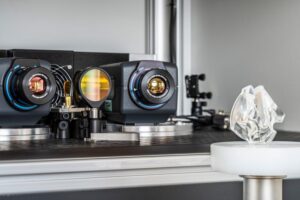Combination of thermography and triangulation
Two thermal imaging cameras analyze the thermal signature left by the narrow and intense infrared line on the object from two different perspectives. Afterwards, a software developed in-house calculates spatial pixels from the information of the two viewing angles and merges them into the exact dimensions of the measured object.
The thermal energy introduced for the 3D analysis is so low that the object is not damaged. The temperature difference between heated and non-heated surfaces is typically less than 3 °C. For this reason, the method is also suitable for sensitive materials.
“By switching from a full-surface thermal pattern to a narrow thermal strip, we have succeeded in advancing the technology in such a way that we can meet the requirements placed on a 3D sensor in industrial use,” emphasizes Martin Landmann, a researcher of the “Imaging and Sensing” department at Fraunhofer IOF. Together with his team and a group of researchers of the innovation alliance “3Dsensation”, he has been working on the system since 2017.






